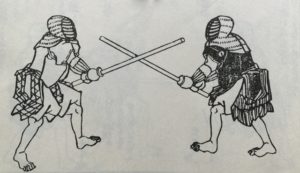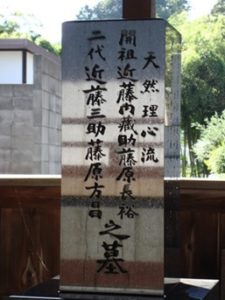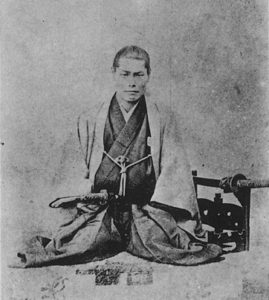The origins of Tennen Rishin Ryū
We could translate Tennen Rishin Ryū as “school (Ryū) of the natural (Tennen) comprehension (Ri) of the spirit (Shin)”. “Without going against nature, we will take the heaven as the model and conform to the earth”. By doing this, the principles of the sword (called kenri) will be achieved.
The Tennen Rishin Ryū is a Japanese traditional swordsmanship school, codified during the Kansei Era (1789-1801) by Kondō Kuranosuke Nagahiro (or Nagamichi). There is limited information in regards to him: he came from Tōtōmi Province (today’s western Shizuoka Prefecture), but we do not know when he was born. He visited many provinces for his musha shugyō, eventually becoming a member of the Kashima Shintō Ryū. Even though he would have most likely been appointed as a teacher of this style, he left the Shintō Ryū aiming to create a new sword based combat system. In fact, during those years the Japanese swordsmanship gradually evolved from the rigid katageiko (form practice performed with either bokutō or with dull-edged swords called habiki) towards a free practice called shinaigeiko (also known as gekiken). This kind of training allowed two practitioners to spar without the risk of severe injury thanks to bamboo swords (shinai) and armors protecting the head (men), the arm (kote), and the torso (dō). With some exceptions, the popular gekiken of the second half of Edo period was quite similar to modern Kendō.

Kuranosuke organized all his martial arts knowledge into a new system of teaching and transmission; for this reason, even if codified during the Edo period, Tennen Rishin Ryū could be listed among new schools called shin ryūha. This was a breaking point between koryū (old schools) and gendai budō (martial arts developed after the Meiji Restoration). He created his own school by synthesizing an actual sword fight every occasion, sticking to a fencing style whose last goal was to obtain full victory without losing composure in front of an enemy. At the end of his musha shugyō Kuranosuke went to Edo. While he was establishing a dōjō in Yagenbori he most likely went to teach in the Sagami area (today’s Kanagawa Prefecture) and Tama area (western part of Tōkyō). Since Tama was the birthplace of 2nd generation (Kondō Sansuke), 3rd generation (Kondō Shūsuke) and 4th generation (Kondō Isamu) headmasters, there is little doubt that this actually happened. Kuranosuke died in the 4th year of Bunka Era (1807).

Grave of Kondō Kuranosuke Nagahiro (ryūso) and Kondō Sansuke Michimasa (nidaime) at Keifukuji, Hachiōji Tobukimachi
Tennen Rishin Ryū became quite popular during the Edo under the leadership of the 3rd generation headmaster, Kondō Shūsuke (sandaime). Within the dōjō, he was running at Ichigaya Yanagichō (the Shieikan), where some of the most talented swordsmen of the Bakumatsu period practiced. The school recorded the highest level of popularity with his son, Kondō Isamu. After having inherited the title of 4th generation headmaster (yondaime) during the 2nd year of Man’en (1861), he became the commander of the Shinsengumi two years later. This was a special police corps established by the Bakufu (the Tokugawa military government) in the 3rd year of Bunkyū (1863), noted for its bloody suppression of antigovernment activity in Kyōto. Four of the thirteen core members of the Shinsengumi were Tennen Rishin Ryū practitioners: Kondō Isamu himself, Hijikata Toshizō (vice commander), Okita Sōji (captain of the first unit) and Inoue Genzaburō (captain of the sixth unit). The other four were guests (shokkaku) at the Shieikan and friends with Kondō: Yamanami Keisuke (Hokushin Ittō Ryū, general secretary of the corps), Nagakura Shinpachi (Shindō Munen Ryū, captain of the second unit), Tōdō Heisuke (Hokushin Ittō Ryū, captain of the eighth unit) and Harada Sanosuke (Hōzōin Ryū, captain of the tenth unit).

Picture of Kondō Isamu, yondaime of the school and commander of the Shinsengumi
The Shinsengumi ceased to exist after the 2nd year of Meiji (1869), with the end of the Boshin War and the collapse of Bakufu. It is commonly believed that the Boshin War marked the end of Tennen Rishin Ryū since Kondō Isamu was sentenced to death and beheaded in Itabashi, Okita Sōji died of tuberculosis, and both Inoue Genzaburō and Hijikata Toshizō died in battle (the first one at Toba-fushimi and the latter in the battle of Goryōkaku). However, this is not historically correct. It was probably a great loss for the Shieikan dōjō, but the tradition survived. There were many teachers of the school at that time, most of them in the Tama area.
References
- Hachiōjishi Kyōiku Iinkai, Hachiōji no Tennen Rishin Ryū – Uketsugareta kenjutsu, jūjutsu, bōjutsu, Hachiōjishi Kyōdo Shiryōkan, 2008
- Kojima Masataka, Bujutsu Tennen Rishin Ryū – Shinsengumi no genryū wo tazunete, Kojima Shiryōkan, 1978
- Watatani Kiyoshi, Yamada Tadashi, Bugei Ryūha Daijiten (Zōho Daikaitei), Tōkyō Kopii Shuppanbu, 1978
